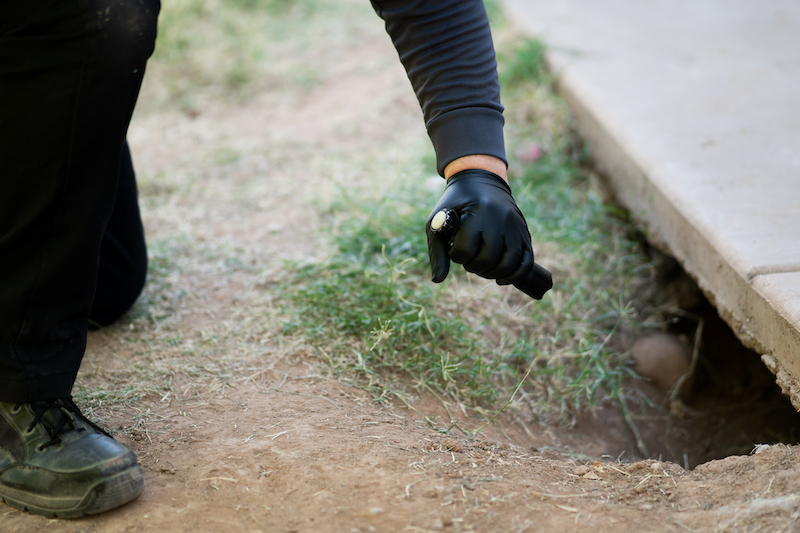Curious about termite inspections? We have the answers for you!
These inspections aren’t just about checking for bugs; they’re essential to protect your home from potential damage. But how long does a termite inspection take? The time can vary depending on your property’s size, how accessible areas are, and the extent of any suspected termite issues.
Let’s dive into what affects inspection times and why these assessments are essential for keeping your home safe and sound.
What Impacts Inspection Time?
The duration of a termite inspection can vary depending on how comprehensive the assessment needs to be:

- Property Size: Larger properties naturally require more time to inspect, especially if the technicians have to cover multiple buildings or extensive outdoor areas.
- Accessibility: Easy access to all parts of the property, including crawl spaces, attics, and basements, can speed up the inspection process. Hard-to-reach or obstructed areas may require more time and effort.
- Level of Infestation: Finding and assessing the extent of infestation may involve more detailed examination and testing.
- Type of Structure: Residential homes typically have more straightforward layouts than complex buildings. The complexity of the structure can affect the length of the inspection.
- Environmental Conditions: Adverse weather conditions (like rain affecting outdoor inspections) and the time of day can also influence the efficiency of the inspection.
How Long Does a Termite Inspection Take?
A thorough termite inspection of residential properties usually takes 1 to 2 hours on average. This timeframe can vary depending on the size of your home, accessibility to crawl spaces and attics, and any signs of suspected termite activity.
Our technicians will perform a comprehensive examination of both the inside and outside of your house, focusing on areas prone to termite infestation, like wooden structures, basements, and utility entry points.
We’ll begin by conducting a detailed walkthrough and inspecting visible areas for signs of termites, such as mud tubes, damaged wood, or discarded wings. During our inspection, we’ll assess the condition of your home’s foundation and look at the landscaping features close to your home that could attract termites.
How Long Does a Termite Inspection Take for Commercial Buildings?
Our skilled technicians can swiftly inspect residential properties in just a few hours. However, commercial inspections require more time and effort, often spanning from several hours to a full day. This duration depends on the building’s size, complexity, and layout.
Commercial buildings, which may have multiple floors, expansive office spaces, and extensive warehouses or manufacturing facilities, pose unique challenges during inspections. Our team still meticulously examines accessible areas prone to termite infestation, including structural supports, plumbing installations, and storage areas.
We carefully evaluate building materials like concrete, metal, and wood to assess their susceptibility to termite damage. We also pay special attention to areas with high moisture levels, like basements, bathrooms, and places susceptible to leaks. This thorough approach guarantees we’ll be able to detect any potential termite issues and provide comprehensive inspection reports.
DIY vs. Professional Inspections
Termite inspections are essential to protect your home from these destructive wood-destroying pests. Whether you’re considering professional help or trying to understand the problem before you give us a call, we have some tips and advice to help you defend your home.
DIY Inspections
If you’re up for conducting your own termite inspection, here are some tips to help you do it effectively:
- Learn the Signs: Educate yourself on common signs of termite activity, like mud tubes, damaged wood, and discarded wings. Focus on inspecting areas where termites are likely to hide, like basements, crawl spaces, and wooden structures.
- Use Basic Tools: Grab a flashlight, screwdriver, and magnifying glass—they’re your best friends for inspecting hard-to-reach spots.
- Check for Moisture Problems: Termites thrive in moisture-rich environments. Inspect areas with leaks, poor ventilation, or standing water.
- Inspect Wooden Structures: Take a close look at the wooden parts of your home, including beams, joists, and window frames. Tap on them to check for hollow-sounding wood, which can indicate termite damage.
- Take Notes: Document any signs of termite activity you find during your inspection. This information will be helpful when you contact a professional for further advice or treatment.
- Consult a Pro: If you discover signs of termites or want peace of mind, don’t hesitate to call a certified pest control professional. We can confirm your findings, offer expert advice, and recommend the best way to deal with any termite issues.
Advantages of Professional Inspections
Our certified termite technicians are trained to spot even the subtlest signs of termite activity. They know where to look and can recommend effective treatments tailored to your home’s needs.

After our inspection, we’ll provide you with a detailed report outlining the problems we found and offer recommendations about your next steps. These reports can help you understand the extent of the problem and decide the best course of action.
Plus, we have access to a wide range of treatments that aren’t typically available for commercial use! Hiring professionals gives you peace of mind, knowing your home is in good hands.
We’ll make sure your property stays protected against termites and spare you the headache of potential pest problems. Contact us today to schedule your termite inspection!

